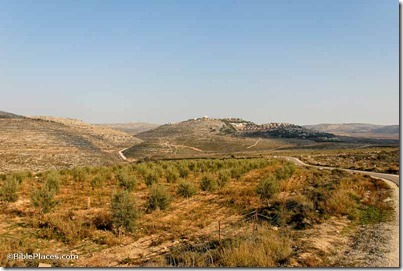There are difficulties in identifying certain cities in the biblical text, but I’ve never seen anything as strange as the location as Bethulia in the book of Judith. The following is abridged from the Bethulia entry by Sidnie Ann White in the Anchor Bible Dictionary (1: 715-16).
BETHULIA (PLACE) [Gk Baityloua (Βαιτυλουα)]. City where the events of the book of Judith are located (Jdt 4:6). The author of Judith gives many indications of the location of Bethulia: it is N of Jerusalem (11:19), near Betomasthaim (4:6), over against Esdraelon (4:6), near Dothan (4:6), in the hill country of Samaria (6:11). It is described as having a spring below the city (7:12–13), and it is positioned to hold the narrow mountain pass giving access to Jerusalem from the N hill country (10:10–11). However, the name Bethulia is unknown to modern readers, and its exact location, despite all the descriptive material, is uncertain. Enslin (1972) points out that we do not even know whether the city was actually known to the author.
[…]
None of these locations is definitive. It is possible that the author of Judith modeled his city on one of the major cities in the N hill country (Shechem being the most likely candidate), but that does not lead to an absolute identification. It seems most helpful to follow Craven (1983) when she says, “It seems best to leave the details of the Book of Judith alone as the products of a fertile, creative imagination.”
This reminds me of an interview once in which I was asked about various place names that sounded somewhat biblical but were clearly misinformed. Though not without its challenges to interpreters 2,000 years later, the Bible clearly stands apart from other religious texts.
To say it another way, there is no Pictorial Library of Apocryphal Lands or Pictorial Library of Mormon Lands because one cannot photograph what did not exist.
Footnote: Not all apocryphal or deuterocanonical texts are ahistorical or a-geographical, but as readers have long recognized, the biblical books are unique.

3 thoughts on “Geography in the Apocrypha”
Todd:
I read a book one time called Mormon's Map by a Mormon fellow named John L. Sorenson. May I suggest you get a copy? It is short and it is a hoot; or perhaps “sad” would be a better word, depending on how you want to approach it. Suffice to say, the BOM is fiction, pure and simple.
Thanks for all you do.
Mike
How true, Todd, and how well you've summarized in your last paragraph the truth we affirm: our faith is rooted in history, not in mystery.
I can’t find Bathulis on the map. Please help.